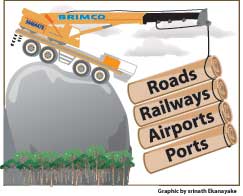
Developing infrastructure for economic growth: Costs benefits and implementation
There can be no doubt that the country’s infrastructure development has been inadequate. Some areas of infrastructure such as roads and transport have been neglected. The state of the country’s railways is a case in point. When Sri Lanka gained independence nearly 60 years ago the country had a relatively well developed infrastructure for a developing country. Financial constraints, especially the difficulty of the government to muster enough finances for its expenditure, as well as foreign exchange difficulties in the 1960s and 1970s, resulted in infrastructure being neglected. When the government faced severe financial difficulties it often cut investments in infrastructure expenditure. There could be no doubt that the poor state of infrastructure has been a serious constraint to rapid growth. This has been repeatedly stated by international agencies, the government itself, the Central Bank, the Institute of Policy Studies and the business community. Infrastructure development is also very costly, the benefits are spread in diverse ways and often indirectly. The gestation period for infrastructure investment to yield benefits is also long and not easily measurable. Infrastructure development is also not confined to physical infrastructure such as roads and railways but also social infrastructure such as education and health. These latter aspects of infrastructure are no less important to long-run economic growth. Social infrastructure development consists of a wide range of investments and are not confined to physical infrastructure such as the building of schools and hospitals, science laboratories and playgrounds. There is a need for development of institutional capacities and of capacity building. These human resource improvements too could be costly. Most of the funding for infrastructure development has been from international agencies. The ADB for instance has focused on selected area of infrastructure development such as the upgrading of road access through development of the road network development of the port to enable a strong connectivity to international markets through the development of the Colombo port. The need to develop the country’s infrastructure is therefore well recognised. The issues regarding infrastructure development lies in the costs of the required investment, the prioritisation of investment in infrastructure development and the tardy implementation and even non-implementation of infrastructure development projects. These are the issues that require to be addressed. The costs of most infrastructure development are large and have to be borne over several years. These investments have large import content too and could create strains for the balance of payments. Therefore the government must find ways and means that would make these problems manageable. Foreign aid, and in some cases foreign investment, are possible options. Commercial borrowing should be avoided as the debt burden could be significant. This is particularly so as the returns on investment in infrastructure are indirect and flow over a longer period of time. This reinforces the argument that borrowing for such investment should be at low cost and repayment should be over a long period of time. Considering the huge costs of infrastructure projects there should be a careful prioritisation of infrastructure projects. If this is not done the country might get itself into severe difficulties and the investment would be counter-productive. It is doubtful that the government has determined its prioritisation in a careful manner. The investment of the second international airport is the glaring evidence of it. Despite the rhetoric of developing infrastructure the process on implementation projects have been tardy. It was years ago that one heard of the Colombo-Kandy highway been built by 2007. Whatever happened to it? Even work on the 22 mile Katunayake express road is in limbo. Special reasons appear to favour the implementation of the Southern Highway. The modern railway system that was to be built by the Indians and then Chinese appears to have been shelved. While recognising the importance of investment in infrastructure, it is also important that these investments are done on a basis of priority and in a cost-effective manner. The manner of financing these projects is also of considerable importance as large sums of money are needed. The speedy implementation of projects is vital if the benefits of these projects are to be realised soon. The fact that infrastructure development is vital to the economy should give a licence to pursue any projects in the name of infrastructure, finance these projects in any manner or implement them partially or in a tardy manner. |
|| Front
Page | News | Editorial | Columns | Sports | Plus | Financial
Times | International | Mirror | TV
Times | Funday
Times || |
| |
Copyright
2007 Wijeya
Newspapers Ltd.Colombo. Sri Lanka. |
 There is a common consensus that the state of infrastructure in the country is a serious constraint to development.
Current economic thinking, the government’s economic policies and the last budget have articulated this position and the government has made provisions for infrastructure development. The Treasury Secretary not so long ago said the first priority was infrastructure, the second priority was infrastructure and the third priority was infrastructure.
There is a common consensus that the state of infrastructure in the country is a serious constraint to development.
Current economic thinking, the government’s economic policies and the last budget have articulated this position and the government has made provisions for infrastructure development. The Treasury Secretary not so long ago said the first priority was infrastructure, the second priority was infrastructure and the third priority was infrastructure.